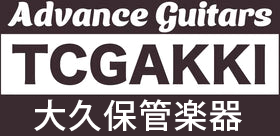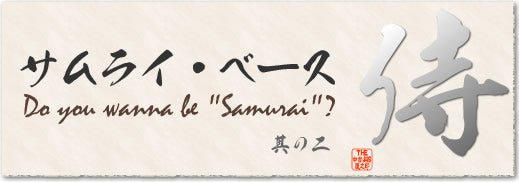

We call "Samurai Bass" the name of the Japanese bass that has been highly praised as "Japan Vintage", and the Japanese brand that has sublimely maintained the Nippon quality since the 1960s. The perfection of domestic basses made the greatest leap from the 1970s to the 1980s, and many "copy" models were produced. In this column, we will not mention the superiority of "originals" and "copies.

Recently, an interesting book was released that expresses the Japanese sense of monozukuri. The book is titled "The Japanese Philosophy of Monozukuri," and the gist of it is that there are two basic types of architecture that represent the "design philosophy" of production and processes.
One is the "fusion type," in which dedicated parts used only for the product are produced, and the other is the "assembling type," in which ready-made parts are used to produce the product. The Japanese manufacturing industry is said to be "overly" devoted to the "matching type," and this is the reason why profits are so thin. The more demanding the customer is, the more the manufacturing capability is developed, but the less profitable it is.
On the other hand, it is understandable that the U.S. is good at "modular" products. This is a very interesting hypothesis that reflects national characteristics.

The dense years since the 1970s that brought the quality of domestic electric instruments to a world-class level are proof of the above. Five years after the invention of the light bulb in the U.S. in 1879, the incandescent light bulb was introduced in Japan, and by 1890, the country had successfully achieved domestic self-sufficiency. The production competition between Japan and the U.S. was built up as a good rivalry between the two countries from this time on.


The biwa, which has its roots in West Asia, is the oldest stringed instrument in Japan, dating back to the 7th~8th century. After landing in Japan, it developed its own unique style as an accompaniment instrument. It is also said that the ancestral form of the stringed instrument existed in Western Asia around the 1st century, and that it was handed down along the Silk Road from the continent of Eurasia (EURO)(ASIA). The biwa biwa appeared in the Heike poetry anthology in the 9th century, and by the 12th century, the Heike biwa had been established along with the Heike Monogatari (Tales of the Heike), a domestic anthology of poetry.
Meanwhile, the shamisen was introduced to Japan in the mid-1500s, and the oldest surviving model is the "Yodo" made in 1597. The body, neck, and strings are made of silk thread, and the neck has a "jointed neck" with a jointed joint for mobility. The form of playing a stringed instrument carried on a string was already established by this time.
The rapid development of domestic electric instrumental instruments in the 1970s was undoubtedly due to the solid know-how backed by history, as mentioned above. It is no wonder that this style of instrument, in which a microphone called a pickup is attached to a wooden body, was introduced from the U.S. and widely spread in Japan.

The copy model, which can be said to be the origin of samurai basses, is often seen as nothing more than an imitation of the original, but by tracking down every detail, we have succeeded in improving the precision of the production. A samurai once said, "The customs of the enemy are strange, but it is important to know each other's enemies," which expresses the Japanese national character. The "rubbing together type" has been accelerated, and now it has become a Japan vintage that will be talked about for the rest of our lives, and the evaluation fever is still high. The factories such as Fuji Gengen Mfg, Matsumoku Kogyo, and Tokai Gakki Mfg. have consistently emphasized the high technical skills of each section in their controlled partial operations as the reason for their breakthrough.

In the '70s and '80s, the manufacturers who are still at the forefront of the domestic market and who have exceeded the severe competition, introduced copy models to their product lineups. Although it is a common story that the quality of products declines due to the mass-production of large-sized products made by manufacturers, the accuracy of standards is required because each part is combined to make the final type, and very detailed workmanship is required, so models from this period are treated as "Japan Vintage," showing off the high technology of Japan. In the factory, where a lot of manpower is required, high-performance machines are used for the parts that require precision, and the parts that contact the wood and the instrument are adjusted by skilled veteran craftsmen to enhance the precision. All wood is subjected to a thorough control to reduce the moisture content and to adjust the stability, strength, and durability of the wood.
On the other hand, from an environmental standpoint, Shinshu-Nagano and Shizuoka are home to many domestic musical instrument manufacturing plants. The wood that makes up the base is rich in moisture absorption and desorption, and adjusts to the surrounding environment by adjusting its own moisture content. The city of Matsumoto, where the musical instrument factory is located, is known as the "home of water," and is rich in spring water, which was used as imperial water for the emperor in the Meiji era. This area also offers a wonderful environment where one can drive for 30 minutes in any direction and enter a lush green forest. On the other hand, Hamamatsu in Shizuoka Prefecture has an average annual temperature of around 16 degrees Celsius (as of 2011), with little difference in temperature between the four seasons. Both cities are blessed with a natural environment, and are inevitably thriving as music cities.

List price at the time of release: 80,000 yen
GRECOJB-800 SUPER REAL
The SUPER REAL series, introduced in the 1980s, was a copy of the original model, created with an exact understanding of the original model and aiming for perfection. The SUPER REAL series is an unparalleled masterpiece that shows off an important milestone in the process of Japanese manufacturers gaining worldwide recognition for their quality.

|
Body: Alder veneer Neck: Maple Fingerboard: Rosewood |
List price at the time of release: 60,000 yen
GRECO FVB-600
The FVB medallion model, based on Gibson '71 specifications, is a coveted Flying V Bass copy model with a superb mahogany sound that was produced only for a short period of time from '74 to '77, when a model that did not exist in the original lineup was realized.

|
Body: mahogany Neck: mahogany Fingerboard: rosewood |
List price at the time of release: 37,000 yen
YAMAHA SB-2
This is the first YAMAHA electric bass model manufactured during the heyday of the Group Sounds, which was released from '66 to '67. After minor changes, the curtain came down in 1982 on this model, the origin of the nostalgic Showa taste that can be considered the holy land of YAMAHA.

|
Body: Katsura Neck: Maple Fingerboard: Rosewood Weight: Approx. 4kg |
List price at the time of release: 120,000 yen
YAMAHA Broad Bass 1200
The Broad Bass series, a new addition to the lineup from the SB series, which has a long and storied history of body shape changes, was launched in the late 1970s with the aim of separating it from the consistent Jazz Bass image of the SB series. The BB series, which is oriented toward the precision bass sound, replaced the SB series and has made history as one of YAMAHA's representative products.

|
Body: Alder Neck: Maple / Mahogany Thru-Neck Fingerboard: Rosewood Weight: Approx. 4.5kg |
List Price at the time of release: 110,000 yen (Pearl White)
Ibanez MC924
The Musician Series was born to match the crossover style of the late '70s. The original EQ tone system is active. Its unique EQ tone system would also guide the future of active sound.
The controls were then limited to active controls and were produced until the early '90s, and were reissued for a very short time in '95 as the Legend Series.

|
Body: Ash (wing section) Neck: Maple/Mahogany 5-ply through neck Fingerboard: Rosewood |
List price at the time of release: 150,000 yen
Aria Pro II SB-R150
The Super Bass series was born from the strong partnership between Matsumoto City's master craftsman Matsumoku Kogyo and Arai Boeki, one of the best Japanese factories at the time, and the family lineup was subsequently expanded.

|
Body: Zebrawood/Chestnut Neck: Maple Fingerboard: Rosewood |
List price at the time of release: 80,000 yen
TOKAIPB-80
The "HARD PUNCHER" is Tokai Instruments' flagship model, and its endless reproduction of Fender's '60s specifications, with a spotlight on each year, is an interesting aspect of the company. The company is also famous for its own factory, which uses a logical manufacturing process that incorporates modern engineering and craftwork.

|
Body: Alder Neck: Maple Fingerboard: Rosewood |
List price at the time of release: 98,000 yen
Fender Japan PB62-98
Japan Vintage, the JV serial model produced by Fuji Stringed Instrument Manufacturing, demonstrated that Fender could produce quality and sound in Japan, and its style of manufacturing in Japan with USA parts became a model that many Japanese manufacturers followed.

|
Body: Alder Neck: Maple Fingerboard: Rosewood |
List price at the time of release: 110,000 yen
FERNANDESMHB-110
The MHB model is a complete reproduction of the popular FERNANDES stone logo Alembic series 1 circuit from the stone logo period, and although the materials used are different, the cost was successfully reduced by attempting to completely reproduce only the circuit. This model is also rare due to its short production period.

|
Body: Sen Neck: Maple Fingerboard: Rosewood Weight: Approx. 4 kg |

In the Samurai Bass column, we have described the process of the Samurai bass, from its romanticization of the great country of America to its eventual growth into one of the best Samurai basses in Japan.
I believe that the unwavering coolness of the Samurai bass is its true appeal. We hope that you will experience the appeal of the sound when you pick up a Samurai bass and see what kind of instrument this is.

We will continue to offer a wide selection of Samurai Vintage instruments at THE Secondhand Music Store, and we are looking forward to your visit to our store.
Thank you very much for your patience.

